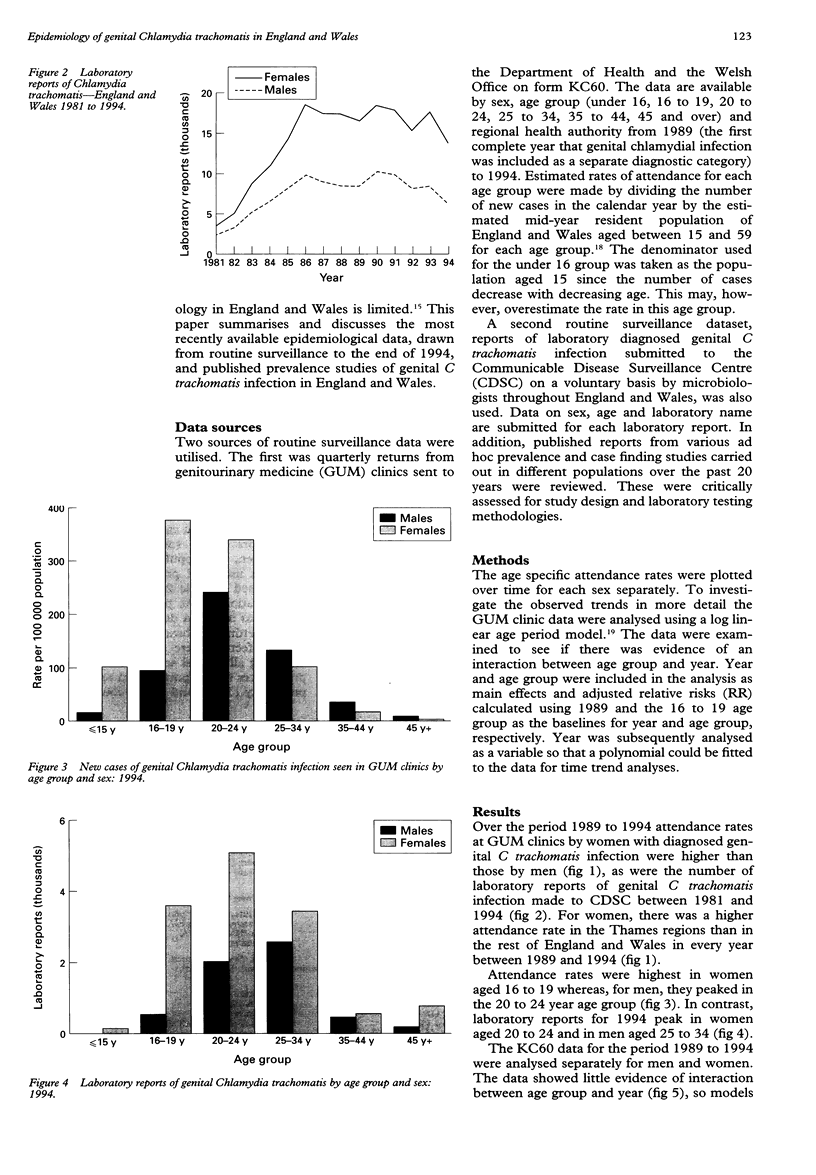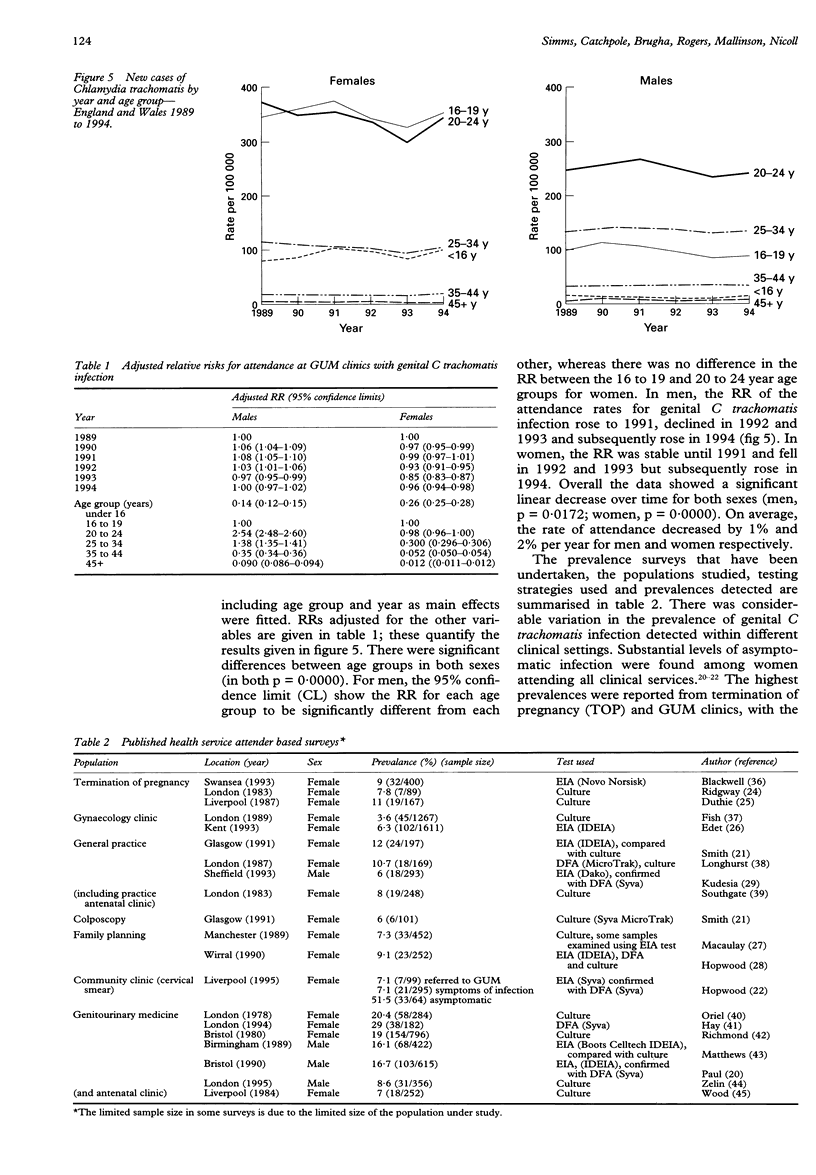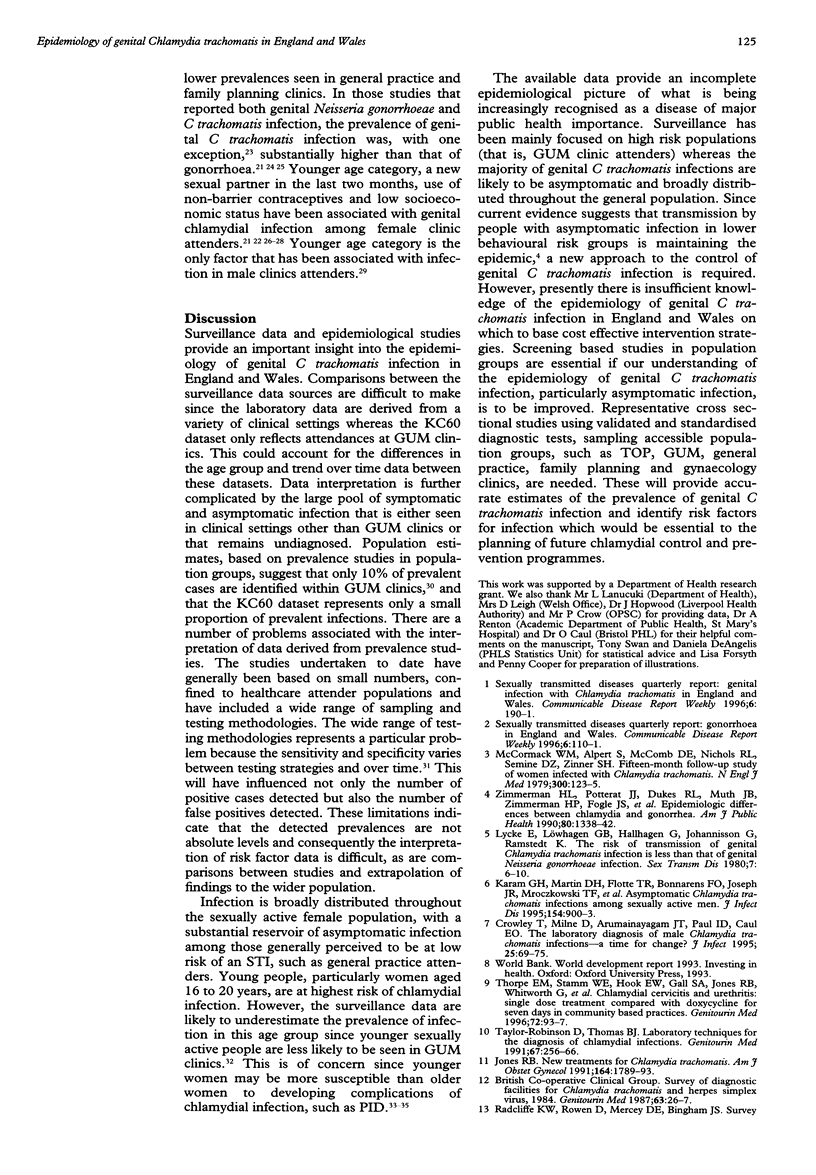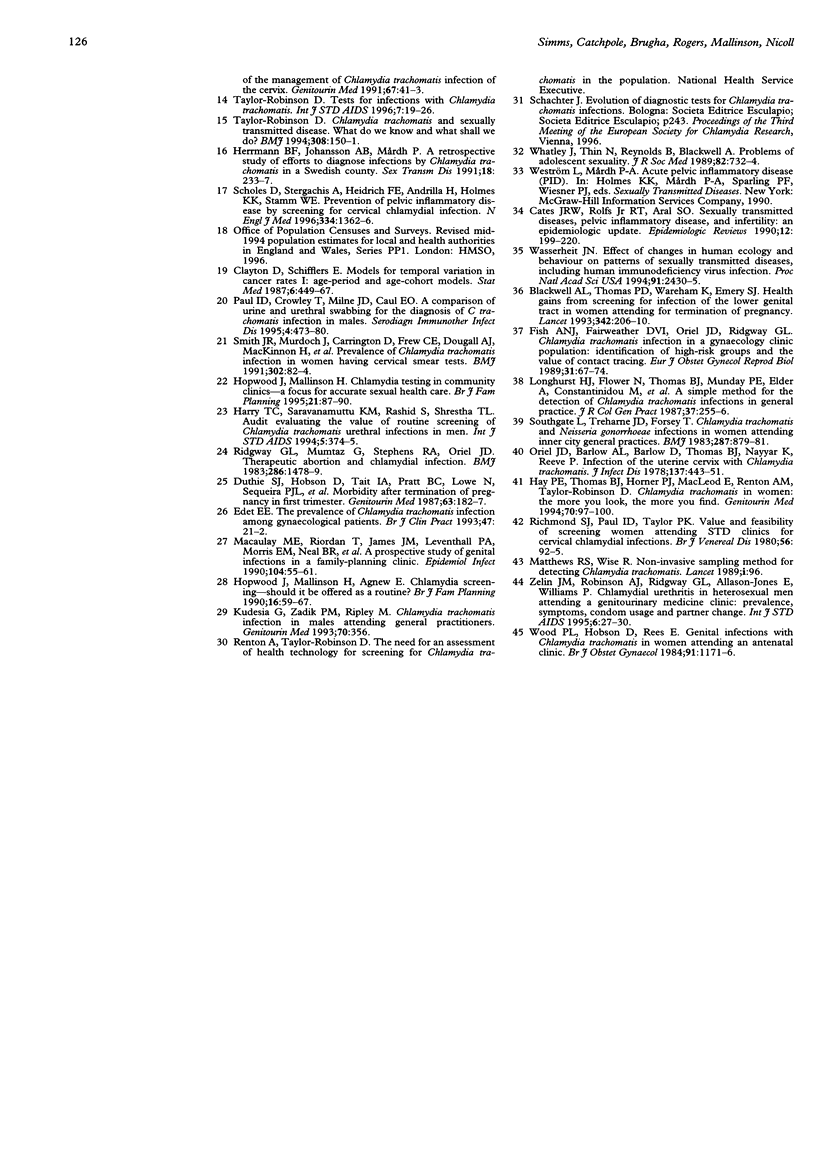Abstract
OBJECTIVE: To describe the recent epidemiology of genital Chlamydia trachomatis infection in England and Wales. DESIGN: Retrospective study of routinely available surveillance datasets and ad hoc prevalence studies. METHODS: Numbers of new cases of genital C trachomatis infection, obtained from the Department of Health and Welsh Office, were combined with the estimated mid-year resident population of England and Wales. Rates were analysed for trend over time using a log linear age period model in GLIM4. Ad hoc prevalence and case finding studies carried out over the past 20 years were critically assessed in terms of study design and testing methodologies. RESULTS: Attendance rates at genitourinary medicine (GUM) clinics were higher for women than men over the period 1989 to 1994 as were the number of laboratory reports. The highest rate of attendance (GUM clinic data) was for women aged 16 to 19 years. There was an overall significant linear decrease in the attendance rates over time for both men (p = 0.0172) and women (p = 0.0000) between 1989 and 1994. There was considerable variation in the prevalence of genital C trachomatis infection detected within different clinical settings, together with a substantial level of asymptomatic infection. CONCLUSIONS: Genital C trachomatis infection is broadly distributed throughout the sexually active population, with a substantial reservoir of asymptomatic infection among those generally perceived to be at low risk of a sexually transmitted infection. Young people, particularly women aged 16 to 19 years, are at highest risk of genital C trachomatis infection. This is of concern since younger women are more susceptible than older women to developing complications of chlamydial infection, such as pelvic inflammatory disease. The broad distribution of infection across all sexually active health service attenders and the high level of asymptomatic infection suggest that a new, screening based, approach to the control of genital C trachomatis infection is required. Recommendations are made as to the epidemiological research required to guide such work.
Full text
PDF




Selected References
These references are in PubMed. This may not be the complete list of references from this article.
- Blackwell A. L., Thomas P. D., Wareham K., Emery S. J. Health gains from screening for infection of the lower genital tract in women attending for termination of pregnancy. Lancet. 1993 Jul 24;342(8865):206–210. doi: 10.1016/0140-6736(93)92299-9. [DOI] [PubMed] [Google Scholar]
- Cates W., Jr, Rolfs R. T., Jr, Aral S. O. Sexually transmitted diseases, pelvic inflammatory disease, and infertility: an epidemiologic update. Epidemiol Rev. 1990;12:199–220. doi: 10.1093/oxfordjournals.epirev.a036054. [DOI] [PubMed] [Google Scholar]
- Clayton D., Schifflers E. Models for temporal variation in cancer rates. I: Age-period and age-cohort models. Stat Med. 1987 Jun;6(4):449–467. doi: 10.1002/sim.4780060405. [DOI] [PubMed] [Google Scholar]
- Crowley T., Milne D., Arumainayagam J. T., Paul I. D., Caul E. O. The laboratory diagnosis of male Chlamydia trachomatis infections--a time for change? J Infect. 1992 Jul;25 (Suppl 1):69–75. doi: 10.1016/0163-4453(92)92099-5. [DOI] [PubMed] [Google Scholar]
- Duthie S. J., Hobson D., Tait I. A., Pratt B. C., Lowe N., Sequeira P. J., Hargreaves C. Morbidity after termination of pregnancy in first trimester. Genitourin Med. 1987 Jun;63(3):182–187. doi: 10.1136/sti.63.3.182. [DOI] [PMC free article] [PubMed] [Google Scholar]
- Edet E. E. The prevalence of Chlamydia trachomatis infection among gynaecological patients. Br J Clin Pract. 1993 Jan-Feb;47(1):21–22. [PubMed] [Google Scholar]
- Ellis H. Midline abdominal incisions. Br J Obstet Gynaecol. 1984 Jan;91(1):1–2. doi: 10.1111/j.1471-0528.1984.tb05269.x. [DOI] [PubMed] [Google Scholar]
- Fish A. N., Fairweather D. V., Oriel J. D., Ridgway G. L. Chlamydia trachomatis infection in a gynaecology clinic population: identification of high-risk groups and the value of contact tracing. Eur J Obstet Gynecol Reprod Biol. 1989 Apr;31(1):67–74. doi: 10.1016/0028-2243(89)90027-0. [DOI] [PubMed] [Google Scholar]
- Harry T. C., Saravanamuttu K. M., Rashid S., Shrestha T. L. Audit evaluating the value of routine screening of Chlamydia trachomatis urethral infections in men. Int J STD AIDS. 1994 Sep-Oct;5(5):374–375. doi: 10.1177/095646249400500520. [DOI] [PubMed] [Google Scholar]
- Hay P. E., Thomas B. J., Horner P. J., MacLeod E., Renton A. M., Taylor-Robinson D. Chlamydia trachomatis in women: the more you look, the more you find. Genitourin Med. 1994 Apr;70(2):97–100. doi: 10.1136/sti.70.2.97. [DOI] [PMC free article] [PubMed] [Google Scholar]
- Herrmann B. F., Johansson A. B., Mårdh P. A. A retrospective study of efforts to diagnose infections by Chlamydia trachomatis in a Swedish county. Sex Transm Dis. 1991 Oct-Dec;18(4):233–237. doi: 10.1097/00007435-199110000-00007. [DOI] [PubMed] [Google Scholar]
- Jones R. B. New treatments for Chlamydia trachomatis. Am J Obstet Gynecol. 1991 Jun;164(6 Pt 2):1789–1793. doi: 10.1016/0002-9378(91)90561-5. [DOI] [PubMed] [Google Scholar]
- Karam G. H., Martin D. H., Flotte T. R., Bonnarens F. O., Joseph J. R., Mroczkowski T. F., Johnson W. D. Asymptomatic Chlamydia trachomatis infections among sexually active men. J Infect Dis. 1986 Nov;154(5):900–903. doi: 10.1093/infdis/154.5.900. [DOI] [PubMed] [Google Scholar]
- Kudesia G., Zadik P. M., Ripley M. Chlamydia trachomatis infection in males attending general practitioners. Genitourin Med. 1994 Oct;70(5):356–356. doi: 10.1136/sti.70.5.356. [DOI] [PMC free article] [PubMed] [Google Scholar]
- Longhurst H. J., Flower N., Thomas B. J., Munday P. E., Elder A., Constantinidou M., Wilton J., Taylor-Robinson D. A simple method for the detection of Chlamydia trachomatis infections in general practice. J R Coll Gen Pract. 1987 Jun;37(299):255–256. [PMC free article] [PubMed] [Google Scholar]
- Lycke E., Löwhagen G. B., Hallhagen G., Johannisson G., Ramstedt K. The risk of transmission of genital Chlamydia trachomatis infection is less than that of genital Neisseria gonorrhoeae infection. Sex Transm Dis. 1980 Jan-Mar;7(1):6–10. doi: 10.1097/00007435-198001000-00002. [DOI] [PubMed] [Google Scholar]
- Macaulay M. E., Riordan T., James J. M., Leventhall P. A., Morris E. M., Neal B. R., Ellis D. A. A prospective study of genital infections in a family-planning clinic. 2. Chlamydia infection--the identification of a high-risk group. Epidemiol Infect. 1990 Feb;104(1):55–61. doi: 10.1017/s0950268800054522. [DOI] [PMC free article] [PubMed] [Google Scholar]
- McCormack W. M., Alpert S., McComb D. E., Nichols R. L., Semine D. Z., Zinner S. H. Fifteen-month follow-up study of women infected with Chlamydia trachomatis. N Engl J Med. 1979 Jan 18;300(3):123–125. doi: 10.1056/NEJM197901183000305. [DOI] [PubMed] [Google Scholar]
- Oriel J. D., Johnson A. L., Barlow D., Thomas B. J., Nayyar K., Reeve P. Infection of the uterine cervix with Chlamydia trachomatis. J Infect Dis. 1978 Apr;137(4):443–451. doi: 10.1093/infdis/137.4.443. [DOI] [PubMed] [Google Scholar]
- Ridgway G. L., Mumtaz G., Oriel J. D., Iriel J. D. Therapeutic abortion and chlamydial infection. Br Med J (Clin Res Ed) 1983 May 7;286(6376):1478–1479. doi: 10.1136/bmj.286.6376.1478-a. [DOI] [PMC free article] [PubMed] [Google Scholar]
- Scholes D., Stergachis A., Heidrich F. E., Andrilla H., Holmes K. K., Stamm W. E. Prevention of pelvic inflammatory disease by screening for cervical chlamydial infection. N Engl J Med. 1996 May 23;334(21):1362–1366. doi: 10.1056/NEJM199605233342103. [DOI] [PubMed] [Google Scholar]
- Southgate L. J., Treharne J. D., Forsey T. Chlamydia trachomatis and Neisseria gonorrhoeae infections in women attending inner city general practices. Br Med J (Clin Res Ed) 1983 Sep 24;287(6396):879–881. doi: 10.1136/bmj.287.6396.879. [DOI] [PMC free article] [PubMed] [Google Scholar]
- Taylor-Robinson D. Chlamydia trachomatis and sexually transmitted disease. BMJ. 1994 Jan 15;308(6922):150–151. doi: 10.1136/bmj.308.6922.150. [DOI] [PMC free article] [PubMed] [Google Scholar]
- Thorpe E. M., Jr, Stamm W. E., Hook E. W., 3rd, Gall S. A., Jones R. B., Henry K., Whitworth G., Johnson R. B. Chlamydial cervicitis and urethritis: single dose treatment compared with doxycycline for seven days in community based practises. Genitourin Med. 1996 Apr;72(2):93–97. doi: 10.1136/sti.72.2.93. [DOI] [PMC free article] [PubMed] [Google Scholar]
- Wasserheit J. N. Effect of changes in human ecology and behavior on patterns of sexually transmitted diseases, including human immunodeficiency virus infection. Proc Natl Acad Sci U S A. 1994 Mar 29;91(7):2430–2435. doi: 10.1073/pnas.91.7.2430. [DOI] [PMC free article] [PubMed] [Google Scholar]
- Whatley J., Thin N., Reynolds B., Blackwell A. Problems of adolescents sexuality. J R Soc Med. 1989 Dec;82(12):732–734. doi: 10.1177/014107688908201210. [DOI] [PMC free article] [PubMed] [Google Scholar]
- Zelin J. M., Robinson A. J., Ridgway G. L., Allason-Jones E., Williams P. Chlamydial urethritis in heterosexual men attending a genitourinary medicine clinic: prevalence, symptoms, condom usage and partner change. Int J STD AIDS. 1995 Jan-Feb;6(1):27–30. doi: 10.1177/095646249500600106. [DOI] [PubMed] [Google Scholar]
- Zimmerman H. L., Potterat J. J., Dukes R. L., Muth J. B., Zimmerman H. P., Fogle J. S., Pratts C. I. Epidemiologic differences between chlamydia and gonorrhea. Am J Public Health. 1990 Nov;80(11):1338–1342. doi: 10.2105/ajph.80.11.1338. [DOI] [PMC free article] [PubMed] [Google Scholar]


